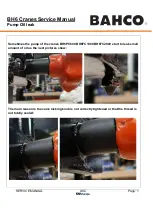
assumed model conditions, such as tissue type, blood perfusion, mode of operation and
actual exposure time of the scanned area. However, the thermal indices provide
information regarding the possible increase in the risk of potential thermal bioeffects and
it provides a relative magnitude that can be used to implement ALARA. In addition to
tissue heating due to the generated ultrasound field, the temperature of the probe head
itself can also increase during the examination. The operator shall be aware, that in the
tissue region near the ultrasonic transducer, there will be a superposition with the
heating due to the ultrasound field, which is not considered by the TI values.
•
Nonthermal effects refer to mechanical phenomena such as cavitation
Nonthermal bioeffects are caused by the interaction of ultrasound fields with very small
pockets of gas (stabilized gas bodies), i.e. the generation, growth, vibration and possible
collapse of microbubbles within the tissue. This behavior is referred to as cavitation
(Medical Ultrasound Safety, 2nd Edition, AIUM 2009/American Institute of Ultrasound in
Medicine Consensus Report on Potential Bioeffects of Diagnostic Ultrasound, AIUM
2008/Guidelines for the safe use of diagnostic ultrasound equipment, Safety Group of
the British Medical Ultrasound Society 2010). The potential of cavitation increases with
the rarefactional peak pressure but decreases with the pulse frequency. Therefore the
Mechanical Index MI was introduced to take account of both the pressure and the
frequency. The higher the MI the greater is the risk of nonthermal bioeffects.
2.10.3 Regulated Parameters
Relevant parameters having physiological effects are regulated according to FDA and IEC
guidelines and standards. These parameters are
Parameter
Meaning
Limit
Displayed
MI
Mechanical Index
1.9
Yes
TIs, TIb, TIc
Thermal Indices TI – one of the following values
can be displayed:
6
Yes
TIs: soft tissues
TIb: bone in focal region
TIc: bone at surface (e.g. cranial)
Ispta.3
Averaged intensity at spatial peak with a
derating of 0.3dB/(cm MHz)
720 mW/cm2
No
T
Temperature at the patient’s side of the probe –
lower limit during patient contact, higher limit for
rest position
43˚C/50˚C (109.4˚F/
122˚F)
No
2.10.4 Interpretation of displayed parameters MI and TI
During obstetric examinations these displayed values shall be observed very critically,
because there may be conditions that are potentially hazardous even below the regulatory
limits.
Some guidelines recommend that embryonic and fetal in situ temperatures of 41˚C (4˚C above
normal temperature) should be limited in time by 5 min or less. Thus, for a reasonable safety
margin, TI values above 1 should be avoided. Additional factors, like temperature of the
mother, are again reasons to keep the TI values as low as possible on the one hand, and go
only as high as necessary to achieve the desired clinical results ('Prudent Use – ALARA
).
The mechanical index, which indicates the risk of cavitation, becomes important at the
interface between gas and soft tissue (nonfetal lung and bowel), but also with the use of gas
body contrast agents. Often an MI value of 0.4 or less is suggested for examinations of tissue
containing stabilized gas bodies. This value arises from operating experience and is not
confirmed.
Safety
Voluson™ SWIFT / Voluson SWIFT+ Instructions For Use
5831612-100 Revision 4
2-19
Summary of Contents for Voluson Swift
Page 343: ......
















































